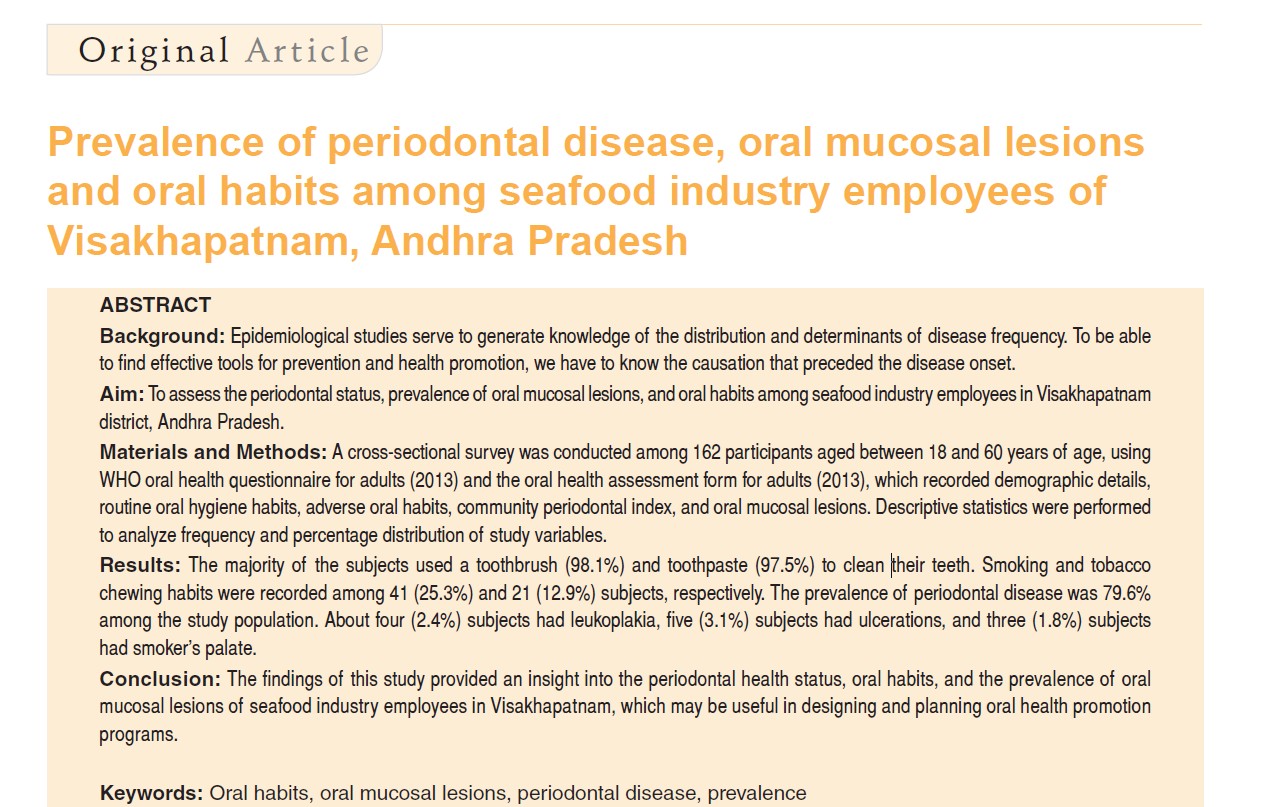Prevalence of periodontal disease, oral mucosal lesions and oral habits among seafood industry employees of Visakhapatnam, Andhra Pradesh
Main Article Content
Abstract
Background: Epidemiological studies serve to generate knowledge of the distribution and determinants of disease frequency. To be able to find effective tools for prevention and health promotion, we have to know the causation that preceded the disease onset
Aim: To assess the periodontal status, prevalence of oral mucosal lesions, and oral habits among seafood industry employees in Visakhapatnam district, Andhra Pradesh.
Materials and Methods: A cross-sectional survey was conducted among 162 participants aged between 18 and 60 years of age, using WHO oral health questionnaire for adults (2013) and the oral health assessment form for adults (2013), which recorded demographic details, routine oral hygiene habits, adverse oral habits, community periodontal index, and oral mucosal lesions. Descriptive statistics were performed to analyze frequency and percentage distribution of study variables.
Results: The majority of the subjects used a toothbrush (98.1%) and toothpaste (97.5%) to clean their teeth. Smoking and tobacco chewing habits were recorded among 41 (25.3%) and 21 (12.9%) subjects, respectively. The prevalence of periodontal disease was 79.6% among the study population. About four (2.4%) subjects had leukoplakia, five (3.1%) subjects had ulcerations, and three (1.8%) subjects had smoker’s palate.
Conclusion: The findings of this study provided an insight into the periodontal health status, oral habits, and the prevalence of oral mucosal lesions of seafood industry employees in Visakhapatnam, which may be useful in designing and planning oral health promotion programs.
Article Details

This work is licensed under a Creative Commons Attribution-NonCommercial-ShareAlike 4.0 International License.
- Share — copy and redistribute the material in any medium or format
- Adapt — remix, transform, and build upon the material
- The licensor cannot revoke these freedoms as long as you follow the license terms.
Under the following terms:
- Attribution — You must give appropriate credit , provide a link to the license, and indicate if changes were made . You may do so in any reasonable manner, but not in any way that suggests the licensor endorses you or your use.
- NonCommercial — You may not use the material for commercial purposes .
- ShareAlike — If you remix, transform, or build upon the material, you must distribute your contributions under the same license as the original.
- No additional restrictions — You may not apply legal terms or technological measures that legally restrict others from doing anything the license permits.
Notices:
You do not have to comply with the license for elements of the material in the public domain or where your use is permitted by an applicable exception or limitation .
No warranties are given. The license may not give you all of the permissions necessary for your intended use. For example, other rights such as publicity, privacy, or moral rights may limit how you use the material.
